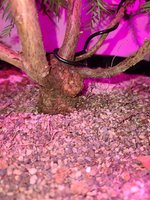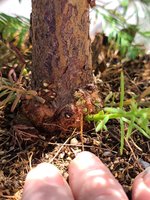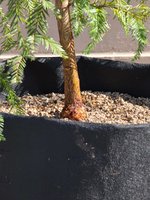LittleDingus
Omono
This will be an unusual question for a bonsai forum because, to my knowledge, burls are NOT encouraged in bonsai culture. While burls can be considered "tree cancer" and are not a good sign on many species, they are pretty common on coastal redwoods (sequoia sempervirens) where they aren't so much a disease as a survival strategy  It' one of the features I love about coastal redwoods both from a horticulture perspective and as a woodworker.
It' one of the features I love about coastal redwoods both from a horticulture perspective and as a woodworker.
I am incredibly excited that two of my coast redwoods have burls!
Here's one growing from...and is the cause of...a mass of branches:

and this tree is growing one from its base...the more typical location for redwood burls:


I very much want to keep these features as these trees grow! What are people's thoughts on how to get these burls to continue to grow...hopefully without taking over the entire tree?!?
I've done some research...and will continue to do more...but it's a hard thing find the right kind of information on! Not a lot of research out there in trying to grow and maintain burls! Burl for woodworking commands a premium to the point where "burl poaching" is a big problem in some areas

 www.northcoastjournal.com
www.northcoastjournal.com
But apparently there's not enough money in it to spawn research on how to grow/manage burls.
Any thoughts/experience people have with growing burls be it good, bad or in between would be greatly appreciated
Thanks in advance!
I am incredibly excited that two of my coast redwoods have burls!
Here's one growing from...and is the cause of...a mass of branches:

and this tree is growing one from its base...the more typical location for redwood burls:


I very much want to keep these features as these trees grow! What are people's thoughts on how to get these burls to continue to grow...hopefully without taking over the entire tree?!?
I've done some research...and will continue to do more...but it's a hard thing find the right kind of information on! Not a lot of research out there in trying to grow and maintain burls! Burl for woodworking commands a premium to the point where "burl poaching" is a big problem in some areas

Crimes Against Nature: Poaching Takes its Toll on the North Coast
They come at night, under the cover of darkness, traversing the back roads of Redwood National and State Parks, home to much of what remains...
But apparently there's not enough money in it to spawn research on how to grow/manage burls.
Any thoughts/experience people have with growing burls be it good, bad or in between would be greatly appreciated
Thanks in advance!














